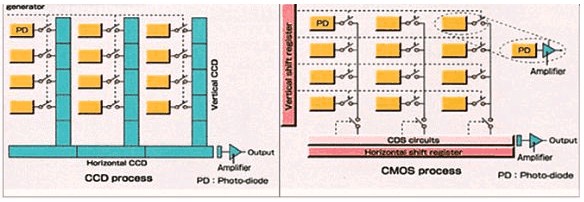CCD and CMOS sensors are two kinds of image sensors that are currently widely used. Both use photoelectric diodes for photoelectric conversion and convert images into digital data. The main difference is that the digital data transmission is different.
As shown in the figure below, the charge data of each pixel in each line of the CCD sensor is sequentially transmitted to the next pixel, and is output from the bottommost part, and then is amplified and output via an amplifier at the sensor edge; in the CMOS sensor, Each pixel is adjacent to an amplifier and A/D conversion circuit, and the data is output in a manner similar to a memory circuit. The reason for this difference is that the special process of the CCD ensures that the data will not be distorted during transmission. Therefore, the data of each pixel can be converged to the edge and then amplified. However, the data of the CMOS process is generated when the transmission distance is long. Noise, therefore, must be amplified before integrating the data for each pixel.
Because of the different data transmission methods, there are many differences in the performance and application of CCD and CMOS sensors. These differences include:
1. Sensitivity difference: Since each pixel of the CMOS sensor consists of four transistors and one photodiode (including amplifier and A/D conversion circuit), the photosensitive area of ​​each pixel is much smaller than the surface area of ​​the pixel itself, therefore With the same pixel size, the sensitivity of the CMOS sensor
Lower than CCD sensor.
2. Cost difference: Since the CMOS sensor adopts the most commonly used CMOS technology for general semiconductor circuits, peripheral circuits (such as AGC, CDS, Timing generator, or DSP, etc.) can be easily integrated into the sensor chip, so the cost of the peripheral chip can be saved. In addition, since the CCD uses charge transfer to transmit data, as long as one pixel cannot be operated, it will cause a whole row of data to be unable to be transmitted. Therefore, controlling the yield of the CCD sensor is much more difficult than the CMOS sensor, even if It is also difficult for experienced manufacturers to exceed 50% within half a year of the product's availability. Therefore, the cost of CCD sensors will be higher than that of CMOS sensors.
3. Resolution Difference: As described above, each pixel of the CMOS sensor is more complicated than the CCD sensor, and the pixel size is difficult to reach the level of the CCD sensor. Therefore, when we compare CCD and CMOS sensors of the same size, the CCD The resolution of the sensor is usually better than the CMOS sensor. For example, currently available CMOS sensors can reach a level of up to 2.1 million pixels (OmniVision's OV2610, released in June 2002), which measures 1/2 inch and has a pixel size of 4.25 μm, but Sony in December 2002. The ICX452 was introduced, which is about the same size as the OV2610 (1/1.8 inch), but its resolution is as high as 5.13 million pixels and its pixel size is only 2.78mm.
4. Noise difference: Since each photodiode of the CMOS sensor needs to be matched with an amplifier, and the amplifier belongs to an analog circuit, it is difficult to make the result obtained by each amplifier consistent, so the CCD sensor with only one amplifier placed on the edge of the chip In contrast, the noise of CMOS sensors will increase a lot, affecting the image quality.
5. Power consumption difference: The image acquisition mode of the CMOS sensor is active. The charge generated by the photodiode is directly amplified and output by the transistor. However, the CCD sensor is a passive acquisition. The applied voltage is required to move the charge in each pixel. In addition, the applied voltage usually needs to reach 12~18V; therefore, in addition to the CCD sensor in the power management circuit design is more difficult (plus the need for additional Power IC), the high driving voltage makes its power consumption much higher than the CMOS sensor level. For example, OmniVision's recently launched OV7640 (1/4-inch, VGA) operates at 30 fps and consumes only 40mW; Sanyo, which is dedicated to low-power CCD sensors, launched 1/7 inch last year. The CIF-class products still have power consumption of more than 90mW. Although the company will introduce 35mW new products in the near future, it still has a gap with CMOS sensors and is still in the sample stage.
In summary, CCD sensors are superior to CMOS sensors in terms of sensitivity, resolution, and noise control, while CMOS sensors are characterized by low cost, low power consumption, and high integration. However, with the advancement of CCD and CMOS sensor technology, the difference between the two has gradually decreased. For example, CCD sensors have been improved in power consumption for use in the mobile communications market (representatives in this regard are Sanyo); CMOS sensors improve the resolution and sensitivity to apply to higher-end image products.

we are professional disposable vape manufacturer from shenzhen china and can offer one stop oem& odm vape service. Disposable vape pen,disposable electronic cigarette,vape pen,disposable ecigs,ecigs pen,e-cigs pen,vape pod,ELFBAR disposable vape pen is portable and fashion disposable electronic cigarette, disposable ecigs pen are trending featured vape pen for vapors as it's safety and easy to use. Disposable vape pod,disposable vape, wholesale vape,vape wholesale,vape pen manufacturer and supplier.disposable vape pen,disposable electronic cigarette,disposable ecigs pen,disposable ecigs stick,disposable e-cigs pen,disposable vape factory,disposable vape pod,disposable vape device,vape pen,vape stick, vape wholesale,wholesale vape,customized dispsoable vape pen,customized vape pen,OEM&ODM disposable ecigs pen,disposable electronic cigarette wholesale, wholesale disposable electronic cigarette,distribute vape pen,vape pen distribute,high quality vape pen,high quality vape pod.
ELF BAR,Tpd Compliant Vapes,Original Onlyrelx Vape,Disposable E-Cigarette Onlyrelx,Vapeorizer Pen
Shenzhen Onlyrelx Technology Co.,Ltd , https://www.onlyrelxtech.com